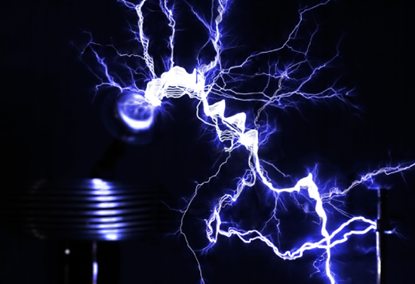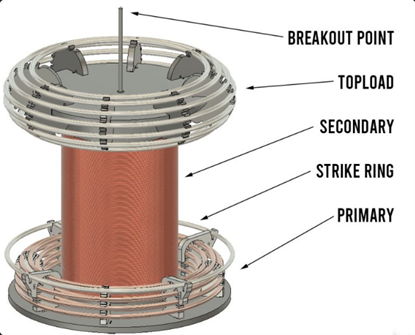


A Tesla coil is a remarkable apparatus capable of generating extremely high voltages. Its primary function is to produce simulated lightning bolts. You might have encountered these devices firsthand at a museum or artistic exhibition.
Alternatively, you may have witnessed them depicted on television or in cinema. This text is intended for those curious about the mechanics behind Tesla coils. Though they come in various forms, they all operate as a type of transformer.
An inductor is a component capable of adjusting voltage levels either upwards or downwards. Its operation relies on the magnetic linkage between two coils. These coils are commonly known as the primary and secondary coils. Fundamentally, when these coils are positioned in close proximity, energy can be transferred between them. In a conventional inductor, the output voltage is determined by the ratio of turns.
However, the Tesla coil operates differently. Its secondary coil exhibits resonant characteristics, allowing it to achieve significantly elevated voltages. The primary feature of a coil is its inductance, while the secondary coil's substantial surface area also imparts capacitance. When a circuit possesses both inductance and capacitance, it enters a state of resonance.
A resonant circuit stores energy, akin to pushing someone on a swing at just the right moments to amplify their momentum. Likewise, the operation of a Tesla coil capitalizes on resonance. Each oscillation at the coil's resonant frequency results in an incremental increase in voltage.

Having covered the fundamentals, let's delve into a standard Tesla coil schematic. Although variations exist, most designs share three primary components. We've already addressed the primary and secondary coils. Now, let's focus on the topload, a prominent toroidal structure positioned atop the Tesla coil. The topload serves two primary functions. Firstly, it shapes the electric field, mitigating the risk of arcs and flashovers. Sparks tend to manifest at sharp points or edges, but the smooth surface of the topload discourages their formation, effectively distancing them from the secondary coil. Secondly, the topload acts as a capacitor, with its capacitance determined by its size. This parameter can be adjusted for various electronic purposes, such as reducing the coil's frequency to accommodate lower frequency transistors. Generally, all Tesla coil specifications are optimized to enhance performance.
The incorporation of a breakout point allows for controlled spark formation, although it's not mandatory. This feature aids in directing sparks, a critical aspect of Tesla coil safety. Without a breakout point, sparks may unpredictably emerge from random locations on the topload.
Having grasped the essence of a Tesla coil, let's explore its two primary variants. The original Tesla coil, reminiscent of Nikola Tesla's designs, employed a spark gap. Spark gap coils dominated the realm of DIY Tesla coils for decades. In contrast, solid-state coils represent the contemporary iteration, favored by hobbyists today.
In a spark gap Tesla coil, a pair of electrodes are positioned closely, akin to a switch. A transformer charges a capacitor to high voltage until an arc forms across the gap. This facilitates the flow of current into the primary circuit. Once energy transfer completes, the arc dissipates, initiating the cycle anew.
Solid state Tesla coils eschew traditional spark gaps in favor of modern switching technologies such as transistors, MOSFETs, or IGBTs. These devices are notably more efficient and dependable compared to their predecessors, boasting expansive capabilities.
Solid state machines offer a plethora of functionalities. Their integration of microcontrollers enables a diverse array of spark effects. Nevertheless, Tesla coil operations typically fall under two primary modes.
CW mode, operating at 100% duty cycle, generates a sinusoidal waveform, yielding mostly silent, bushy sparks. This mode is instrumental in producing high-quality audio, leveraging various modulation techniques to achieve desired effects.
In interrupted mode, the high-frequency signal operates intermittently, characterized by short bursts. By shortening these bursts, higher primary currents are attainable, enabling the production of long sparks with reduced input power.
The Single Resonant Tesla Coil (SSTC) represents the fundamental iteration of this technology. Its designation as "single resonant" pertains to the resonance of the secondary coil. Typically, a solid-state driver is linked to the primary via a capacitor, selected to avoid primary resonance. This configuration illustrates the fundamental operation of a Tesla coil using basic techniques.
Class E Tesla coils feature resonant primary capacitors and coils. These circuits find common application in commercial RF amplifiers, serving as the foundation for early solid-state coils. Leveraging a single transistor, they offer simplicity in design. However, their primary and secondary tuning must be delicately mismatched to achieve optimal switching characteristics, distinguishing them from other coupled tuned circuits. A notable challenge is their susceptibility to calibration difficulties due to the dynamic nature of the spark load.
Dual Resonant Solid State Tesla Coils (DRSSTCs), often referred to as DRSSTCs, employ half or full bridges to drive a series-tuned primary circuit. Renowned for their potency, these coils leverage the tuned primary circuit to accommodate significantly higher energy inputs. DRSSTCs serve as the cornerstone for more intricate variations, such as Quasi-Continuous Wave (QCW) Tesla coils, a topic we'll explore more extensively in subsequent discussions.
Advancements in these technologies are perpetual. We endeavor to keep this document updated as both the technology and our comprehension of it evolve. We trust it has provided illumination on the workings of Tesla coils. Should you desire further elucidation on any aspect, please reach out to www.blikai.com!